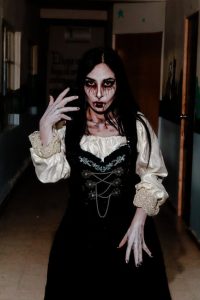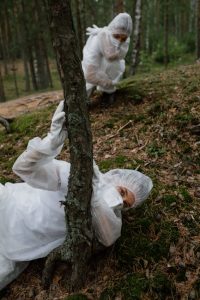What We Do in the Shadows: A Hilarious Look at the Undead
In the vast landscape of television, where zombies and werewolves reign supreme, one show stands apart with its unique brand of humor and heart: *What We Do in the Shadows*. This mockumentary, a hilarious look at the lives of a group of vampires sharing a flat in Staten Island, has become a beloved cult classic, capturing the hearts of audiences worldwide. The show’s success lies in its ability to take a familiar genre, the vampire story, and turn it on its head, offering a fresh and irreverent perspective on the undead.
Created by Jemaine Clement and Taika Waititi, the brains behind the original 2014 film of the same name, *What We Do in the Shadows* transports viewers into a world where ancient vampires navigate the mundane challenges of modern life. The show follows the misadventures of Nandor, a centuries-old vampire struggling with the complexities of human interaction; Laszlo, a debonair and mischievous vampire with an endless supply of schemes; Nadja, a stylish and cunning vampire who is often at odds with her roommates; and Guillermo, Nandor’s loyal familiar who is desperate to become a vampire himself. Each character is a unique blend of absurdity and pathos, making them both relatable and hilarious.
The show’s mockumentary format allows for a level of intimacy and authenticity that is often missing in traditional vampire narratives. Through the lens of a documentary crew, viewers are given an unfiltered glimpse into the daily lives of these vampires, revealing their quirks, anxieties, and vulnerabilities. This approach allows for a more nuanced and complex portrayal of these creatures, challenging traditional stereotypes and showcasing the human side of the undead.
For example, Nandor’s struggles with modern technology and his attempts to understand human relationships are both relatable and comedic. Laszlo’s playful and mischievous nature, often bordering on the absurd, provides a constant source of amusement. Nadja’s fierce independence and her struggles with the limitations of her immortal life offer a glimpse into the complexities of female agency in a patriarchal world. And Guillermo’s unwavering loyalty to Nandor, despite his desire to become a vampire himself, highlights the power of friendship and the complexities of identity.
With its witty dialogue, absurd situations, and lovable characters, *What We Do in the Shadows* has earned critical acclaim and a loyal fanbase. Its popularity has spawned a spin-off series, *Wellington Paranormal*, and even a stage adaptation. The show’s success can be attributed to its clever blend of humor, heart, and satire. It not only provides laughs but also offers thoughtful insights into the human condition, exploring themes of friendship, loneliness, and the search for belonging.
In a world where vampires are often portrayed as menacing and terrifying, *What We Do in the Shadows* offers a refreshing and humorous take on these creatures. By showcasing their vulnerabilities and struggles, the show humanizes these mythical beings, making them relatable and even sympathetic. The show’s success is a testament to the power of humor to break down barriers and challenge preconceived notions, reminding us that even the most fearsome creatures can be surprisingly relatable.
The Mockumentary Format
One of the key factors contributing to the show’s success is its innovative use of the mockumentary format. By presenting the vampires’ lives as a documentary, *What We Do in the Shadows* creates an immediate sense of relatability. Viewers are drawn into the characters’ world through the intimate, fly-on-the-wall perspective, witnessing their everyday struggles and triumphs firsthand. This format allows for a unique blend of humor and pathos, as the audience is privy to both the absurdity of their situation and the genuine emotions that drive them. The mockumentary style also allows for a more natural and spontaneous delivery of dialogue, enhancing the comedic timing and improvisation that are hallmarks of the show.
The mockumentary format also allows the show to lampoon the tropes and conventions of vampire fiction. By turning the vampire stereotype on its head, *What We Do in the Shadows* finds humor in the absurdity of ancient beings trying to adapt to modern society. For example, instead of being suave and sophisticated, the vampires are often clumsy, clueless, and prone to making embarrassing mistakes. They struggle with technology, have outdated fashion sense, and are constantly surprised by the changing world around them. This subversion of expectations is a key part of the show’s appeal, as it allows viewers to see these iconic creatures in a new and unexpected light.
The Characters
The show’s success is also largely due to its well-developed and endearing characters. Each vampire has their own unique personality and quirks, making them both hilarious and relatable. Nandor, for example, is a complex character who is both arrogant and insecure, struggling to reconcile his ancient lineage with his modern-day existence. He yearns for connection and meaning but often sabotages his own attempts at finding it. His constant need for validation and his tendency to overcompensate for his perceived shortcomings make him a source of endless amusement. Laszlo, on the other hand, is a charming rogue with a mischievous streak, constantly pulling pranks and causing chaos. His witty banter, his love for the finer things in life, and his ability to find humor in any situation make him a beloved character.
The show also features a strong supporting cast of characters, including the brilliant and witty Colin Robinson, an energy vampire who feeds off the boredom of others. His deadpan delivery and his ability to drain the life out of any conversation make him a unique and hilarious character. The show’s ensemble cast creates a dynamic and hilarious ensemble, each character adding their own unique flavor to the mix. The relationships between the vampires are complex and ever-evolving, adding another layer of depth and humor to the show.
The Themes
Despite its comedic tone, *What We Do in the Shadows* explores surprisingly deep themes. The show tackles issues of friendship, loneliness, and the search for belonging. The vampires, despite their immortality and supernatural powers, are ultimately searching for connection and meaning in their lives. They are constantly grappling with the limitations of their existence, the challenges of maintaining relationships, and the futility of their endless search for purpose. The show’s exploration of these themes is both poignant and relatable, as it resonates with the universal human experience of seeking connection and meaning in a world that can often feel isolating and meaningless.
The show also touches on themes of identity and acceptance. The characters, especially Nandor, are constantly grappling with their own identities and how they fit into the world. They are often confronted with the prejudices and fears that humans hold towards them, forcing them to confront their own prejudices and biases. The show’s exploration of these themes is both timely and relevant, as it reflects the ongoing struggle for acceptance and understanding in a world that is increasingly divided. Through its humor and insightful exploration of human nature, *What We Do in the Shadows* has become a cultural phenomenon. The show has resonated with viewers of all ages and backgrounds, proving that even in the darkest of times, there is always room for laughter and a touch of humanity.
In conclusion, *What We Do in the Shadows* transcends the typical vampire comedy, offering a refreshingly insightful and humorous exploration of the human condition. The show’s mockumentary format allows for a unique perspective on the lives of these ancient beings, revealing their struggles, anxieties, and vulnerabilities in a relatable and often hilarious way. The characters, from the narcissistic and self-absorbed Nandor to the perpetually awkward Guillermo, are wonderfully flawed and endearing, making viewers laugh and empathize with their struggles to navigate the modern world.
Beyond the comedic elements, *What We Do in the Shadows* tackles themes of loneliness, isolation, and the search for connection. The vampires’ eternal existence, while seemingly glamorous, often leaves them feeling isolated and disconnected from the world around them. The show explores the complexities of their relationships with each other, with humans, and with their own mortality, prompting viewers to reflect on their own experiences with these universal themes. The show’s ability to seamlessly blend humor and pathos is a testament to its clever writing and the talented cast who bring these characters to life.
The success of *What We Do in the Shadows* is evident in its critical acclaim and dedicated fan base. The show has received numerous awards and accolades, including a Primetime Emmy Award for Outstanding Comedy Series in 2020. Its popularity has also spawned a spin-off series, *Wellington Paranormal*, which follows the adventures of two New Zealand police officers who investigate paranormal activity. The show’s impact on popular culture can be seen in its numerous memes and references, proving its lasting influence on the comedic landscape.
Ultimately, *What We Do in the Shadows* is a testament to the power of humor to connect with audiences on a deeper level. By embracing the absurd and the unexpected, the show offers a fresh perspective on familiar themes, reminding us that even in the darkest of times, there is always room for laughter and hope. If you are looking for a show that will make you laugh, think, and feel, then *What We Do in the Shadows* is a must-watch.

Photo by Oswaldo López on Pexels







